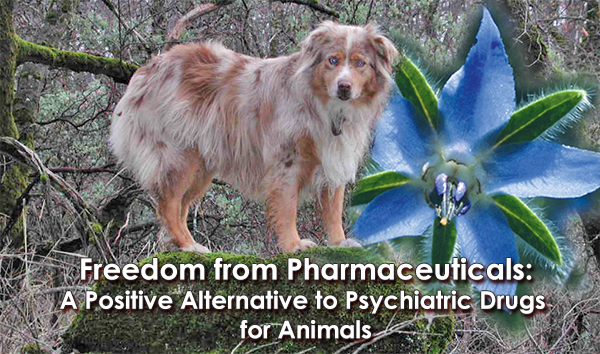
by Jann Garitty
The choice to use “behavior modification medications” with animals has increased in recent years, mirroring the same trend toward prescribing psychiatric drugs more frequently for humans as well. The issues and ethics in regard to the use of psychiatric medications are complex with varied points of view expressed by pet owners, animal behaviorists, shelter workers, veterinarians, other practitioners and pharmaceutical companies. Treating animals with psychiatric drugs: a brief overview The relationship between us and our animal companions is defined in part by our individual lifestyles. Each of our animals is unique in its personality, emotional makeup and ability to adapt or thrive in our living environments. Unfortunately, in some circumstances, the environment and training necessary is inadequate to ensure the quality of life that our animals need and deserve. As a result, oftentimes our animals exhibit problematic or unsocial behaviors. These behaviors reflect their underlying emotional conditions and stem from their souls and their relationship with us, others and nature. There are a variety of treatments for companion animal behavioral problems. These treatments include behavioral modification training, prescription drugs with or without behavior training and holistic treatments such as flower essence therapy. While behavioral modification and prescription drugs address overt behaviors or symptoms, holistic treatments, especially flower essence therapy, address and remedy the underlying emotional-soul condition that is causing the behaviors. On- and off-label prescriptive drugs “According to the marketing research firm Ipsos, animal-lovers in the U.S. spend 15 million dollars (U.S.) on a variety of medications for behavior management in dogs and cats.” 1 There are only two prescriptive medications for behavioral problems approved for use with animals by the U.S. Food and Drug Administration (FDA). However, there are many others which are prescribed “off-label” by veterinarians to treat a variety of emotionally-based behavioral issues such as aggression. Off-label, also sometimes called “extralabel,” medications are those that have been approved for human use but not for animals. “Extralabel use can also mean prescribing a drug to a different species, for a different condition, or in a different dosage than that for which the drug was approved.” 2 The following are examples of off-label medications readily available at online pet pharmacies:
Alprazolam (Xanax®)
Best or worst case scenario? At best, these psychiatric drugs prescribed off-label can alleviate similar symptoms for which they are prescribed for humans, but at worst, they can cause severe side-effects, toxicity and in some cases, even death. “Since 1998, The American Society for the Prevention of Cruelty to Animals (ASPCA) Animal Poison Control Center reports that it has received more than 1,075 calls concerning antidepressant medication ingestion by dogs.” 3 An article by Tina A. Wismer, DVM, entitled “Antidepressant drug overdoses in dogs” can be read here. Close to 300 medications have been approved for use with animals for physical conditions, but as mentioned above, there are only two FDA-approved behavior modification medications. 4 They are Clomicalm (clomipramine hydrochloride) to treat separation anxiety (containing the same active ingredient as in the human anti-depressant, Anafranil) 5 and Anipryl (selegiline hydrochloride, L-deprenyl hydrochloride) to control the behaviors associated with canine Cognitive Dysfunction Syndrome (CDS). Some of the behaviors associated with CDS are disorientation, decreased activity level, sleep cycle abnormalities, loss of house training, and changes in relationships and responsiveness to family members. According to Novartis, the company which manufactures Clomicalm, “…signs of separation anxiety evaluated in controlled trials were vocalization, destructive behavior, excessive salivation, and inappropriate elimination. In the absence of the owner or attachment figure, dogs with separation anxiety may exhibit one or more of these clinical signs. Although the owner (attachment figure) may inadvertently misinterpret this behavior, which only happens in their absence, as spiteful, it is thought to be the result of anxiety experienced by the dog. Punishment is not considered appropriate for a dog with separation anxiety.” 6 Separation anxiety affects as many as seven million dogs in the U.S., according to Hans-Beat Gurtler, director of Novartis Animal Health in Basel, Switzerland, the company's home base. 7 The complexity of the issue deepens: a question of doing the wrong thing for the right reason? Novartis also advocates the use of a behavior modification program to accompany the use of the medication. 8 The company provides a detailed protocol outlining the type of training that should occur in conjunction with the administration of the drug. In fact, other published information concurs that without behavior modification therapy and environmental management, medication alone would most likely not be effective. There are many lists of resources available to consult regarding behavior modification techniques, one such list is provided by the Animal Behavior Clinic—Purdue University and can be read here . According to the Humane Society of the United States, “Behavior problems top the list of reasons for pet relinquishment.” 9 Many of these abandoned animals are euthanized. Therefore, it is considered by some to be humane to give medications to remedy problem behaviors and emotional conditions due to separation from their humans or due to one of many other reasons. But, are psychiatric drugs the answer? Kathy Edstron , a dog trainer and pet behavior consultant, questions the over-reliance on pharmaceutical treatment for animal behavior problems; “While conventional medicine and veterinary care are a necessity…I don’t believe that companion animals should be given a psychiatric drug for a behavior problem, especially not without a good, positive training program in place and in use. If an animal is behaving dangerously towards humans or could potentially injure himself, then medication might be necessary to alter the brain chemistry of that animal. If the drug provides a sedative effect, this might give the caretaker an opportunity to locate and work with a qualified, positive trainer who can develop a behavior modification program specific to that dog’s needs.” Kathy contends, “Especially without a well-rounded training program, a psychiatric drug offers a superficial, ‘quick fix’ approach to a complex problem.”
Over the years, Kathy has heard of many animals being given anti-depressants, sedatives or tranquilizers with unsatisfactory results, “The common thing that happens once an animal is taken off the drug is that the dog then often reverts to the same undesirable behavior. The drug did not ‘fix’ the problem, it just masked it. Sadly, when the dog resorts to the original behavior, the dog is either put back on the drug, sometimes at a higher dosage, or the animal is taken to the shelter because the caretaker doesn’t know how to handle the issue or simply does not want to put the time into helping their canine companion work through the issues by using positive training techniques. In my opinion, it is a vicious cycle.” Many veterinarians admit they are not well educated in the field of canine psychology or animal behavior. They are willing to prescribe pharmacological drugs for behavior problems, often because they are not aware of other treatment options and their clients desire quick solutions. Kathy recommends that all veterinarians should at least maintain a list of highly qualified, positive animal behavior trainers for referral to clients requesting medications for pet behavioral problems. Witness to the dangers of pharmaceutical treatment To illustrate the potential danger of prescribing pharmaceuticals to animals, Kathy cites, “A client of mine recently attended an agility trial with her Australian shepherd, where she overheard a person telling another to put her dog on Ace Promazine to calm the dog down. My client went on to tell me how she was appalled that trainers are recommending using a sedative on dogs that are high energy in agility. This is one sport that you absolutely don’t want to sedate an animal. It can be downright dangerous! There are several pieces of equipment where the dogs could get severely injured if in a sedated state and attempted to do those particular agility obstacles. “I have personally witnessed the bad side effects a Black Labrador experienced while receiving Ace Promazine; his condition worsened. The dog became unaware of his surroundings, still acted out in fear during storms and walked around like he was drunk. This is a very common effect.” Freedom from pharmaceuticals – flower essence therapy as a solution Animal practitioners have found flower essence therapy to be effective for a wide variety of behavioral difficulties. By addressing the internal emotional condition of the animal, outward behavior can be restored to a state of balance and appropriateness. Richard Katz of the Flower Essence Society notes that “Flower essences are a non-invasive, longer-lasting alternative to pharmaceutical drugs as a support for behavior therapy in that they address underlying patterns and are a catalyst for changing animal emotions (fear, anxiety, etc.) that can lead to behavioral change. This is a further step from the drug/behavior modification approach; flower essence therapy is natural and non-invasive and is more than behavior modification in that it addresses underlying emotional states. “In other words, if a dog who is afraid of thunderstorms is treated by behavior modification desensitizing techniques, the dog might be exposed to tape recordings of thunder at ever increasing levels until it is habituated to the sound. With the use of flower essences, the dog’s basic emotional stance towards life is changed such that it is no longer prone to anxiety attacks. The difference might be that a “desensitized” dog would then get jumpy at the sound of firecrackers [or another similar loud noise] until desensitized to that sound as well, whereas the dog treated with flower essences would react less to all stimuli.”
Kathy Edstrom is very enthusiastic about using flower essences with animals. Flower essence therapy often takes several months, as though removing “layers of an onion, working deeply and thoroughly, layer by layer, to truly resolve the issues…[it is necessary] to understand the emotional state of the animal companion, reviewing and discussing all aspects of that animal’s life.” She further asserts, “Flower essences are so great to use with animals because you can customize the blend to really suit their individual needs. Also, there is never a placebo effect with an animal. Unlike with humans, the animals don’t know the blend is targeting fear issues, separation anxiety or whatever; it either works or it doesn’t.” Read a case study from Kathy Edstrom—
Learn how a dog adopted from an animal shelter
transitions from pharmaceutical drugs toward greater freedom and joy
:
Footnotes (1) https://www.ipsos.com/en-us/truth-about-cats-dogs(2) https://www.fda.gov/animal-veterinary/guidance-regulations/animal-medicinal-drug-use-clarification-act-1994-amduca (3) https://www.aspca.org/pet-care/animal-poison-control (4) https://www.fda.gov/animal-veterinary/guidance-regulations/animal-medicinal-drug-use-clarification-act-1994-amduca (5) https://www.fda.gov/animal-veterinary/guidance-regulations/animal-medicinal-drug-use-clarification-act-1994-amduca (6) https://dailymed.nlm.nih.gov/dailymed/drugInfo.cfm?setid=ee50609c-39e6-452d-94f3-0622bb8a0720 (8) https://dailymed.nlm.nih.gov/dailymed/drugInfo.cfm?setid=ee50609c-39e6-452d-94f3-0622bb8a0720 (9) https://www.humanesociety.org/issues/keeping-pets-life
Other Resources
|

To install this Web App in your iPhone/iPad press ![]() and then Add to Home Screen.
and then Add to Home Screen.

